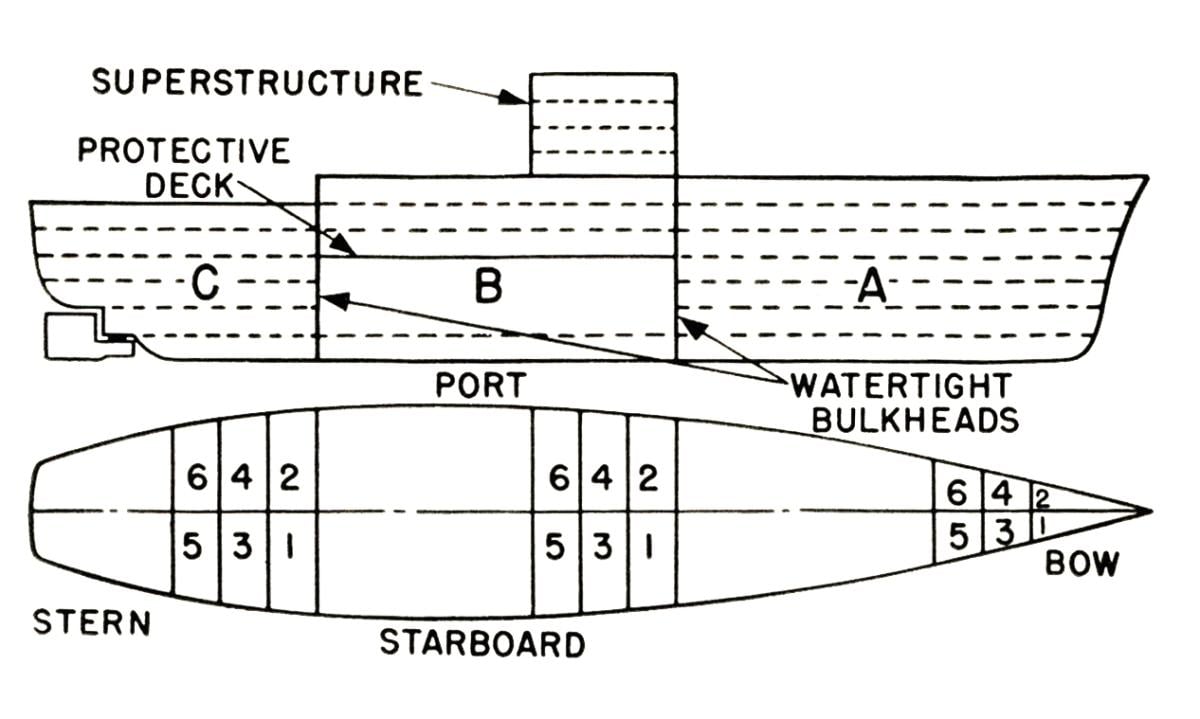In the December 2018 “Bluejacket’s Manual,” we explored finding one’s way around a Navy ship. That system of compartment identification only came into practice in 1949. Ships built before that time used a different method of identifying compartments and spaces.
In the pre-1949 system, each compartment was labeled with a formatted designation, such as:
C-207 A
The first letter gave a rough estimation of the compartment’s location fore and aft. That letter was always A, B, C, or D. Many ships did not include the “D” designation, which will be explained later. We will first consider a ship using only the first three letters, which divided the vessel into three sections, “A” being the forwardmost, “C” being the aftermost, and “B” comprising those compartments amidships.
The boundaries for these designations were based on the ship’s propulsion plant, with the “B” section defined as beginning at the forward transverse bulkhead and ending at the after transverse bulkhead of the engineering spaces. This included not only the engineering spaces, but all compartments above them as well.
The numbers in the middle of the designation provided information about the compartment’s vertical and horizontal location. The digits combined to indicate what deck the compartment was on and where it was on that deck. Compartments on the main deck—the uppermost deck that runs the whole length of the ship, from stem to stern—had 100-series numbers (101, 102, 103, etc.); those on the next deck below (called the “second deck”) used 200-series numbers; the third deck used 300-series numbers, and so on. No matter how many decks a ship had, those spaces in the ship’s “double bottom” (consisting of the two lowest complete decks) always were given 900-series numbers.
Above the main deck, the numbers added a “0” (zero) before the number series, with the numbers increasing as the levels went up. This means, for example, that if the bridge was four levels above the main deck, it would be given a 0400-series number.
Whether using a three-digit number to indicate the main deck and below, or a four-digit number to indicate spaces above the main deck, the remaining digits indicated the location relative to the ship’s centerline, with those on the port side having even numbers and those to starboard using odd numbers. If the designation ended in zero, it would have been on the centerline.
The third part of the designation was a letter or group of letters that indicated the use (or multiple uses) of the space.
In our opening example, the compartment indicated would have been in the after third of the ship, on the second deck, and on the starboard side of the ship, and would have been used for stowage unrelated to engineering or weapons.
As mentioned earlier, some ships included a fourth major division, labeled “D.” This reflected the very large and redundant engineering spaces that were essential in large warships. In this configuration, “D” was the last section of the ship and divisions “B” and “C” encompassed the engineering spaces. As explained in the 1943 Bluejackets’ Manual:
Division B.—This comprises . . . all the space between the forward and after transverse bulkheads of the forward group of boiler compartments and the forward and after transverse bulkheads of the after group of boiler compartments.
Division C.—This comprises all the space between the after transverse bulkhead of the after boiler compartment and the after transverse bulkhead of the after compartment assigned to main propulsion machinery or auxiliaries of main propelling machinery, or where boiler compartments are located forward and aft of the engine rooms, division C comprises all the space between.
This convoluted description becomes clearer with the knowledge that boiler rooms and engine rooms were kept separate from each other, and that there often were redundant boilers and turbines for added power and in the event of battle damage. For example, a heavy cruiser would have her boilers configured beneath her stacks in section “B” of the ship, and her turbines, reduction gears, and condensers in section “C.”
Comparing the new system to this older one, it should be fairly obvious that the new system allows for greater precision and less confusion.




